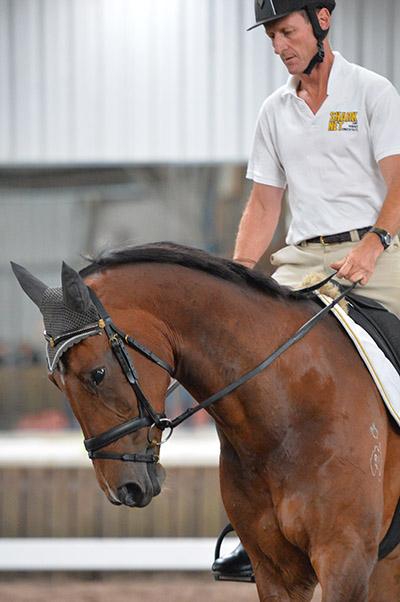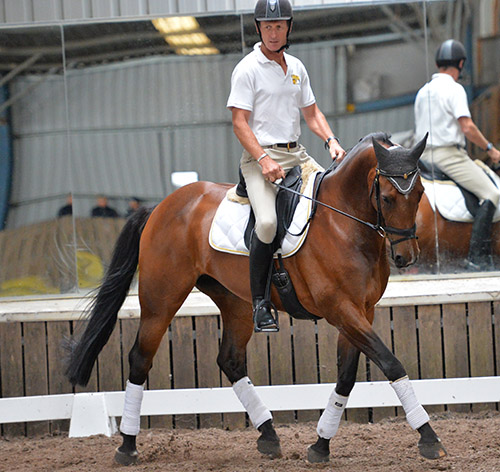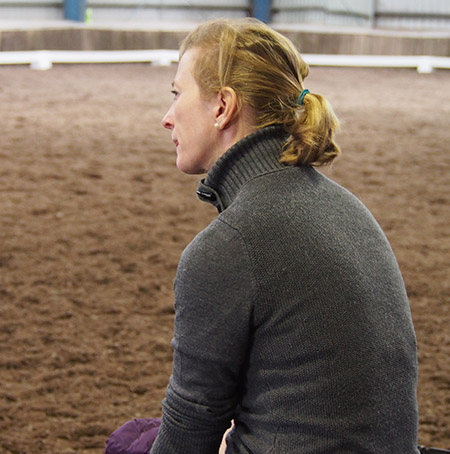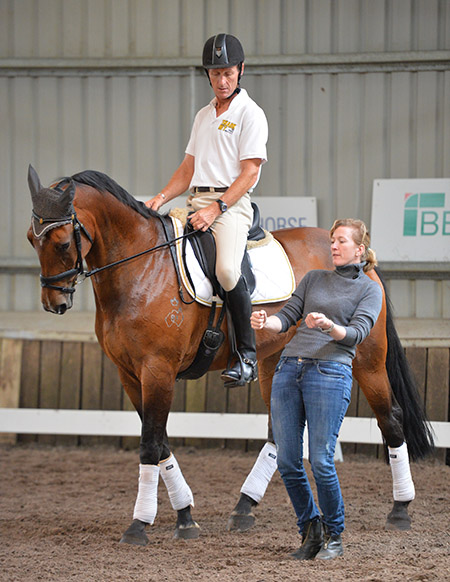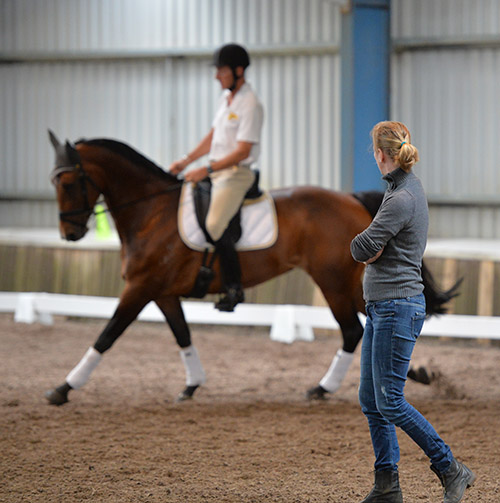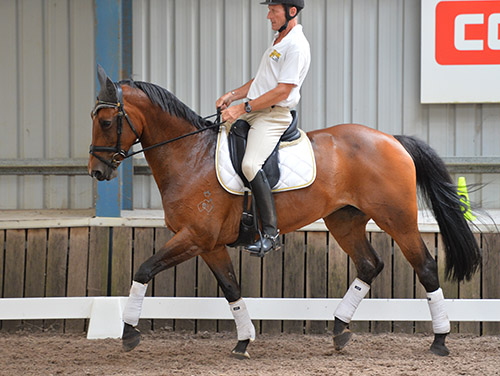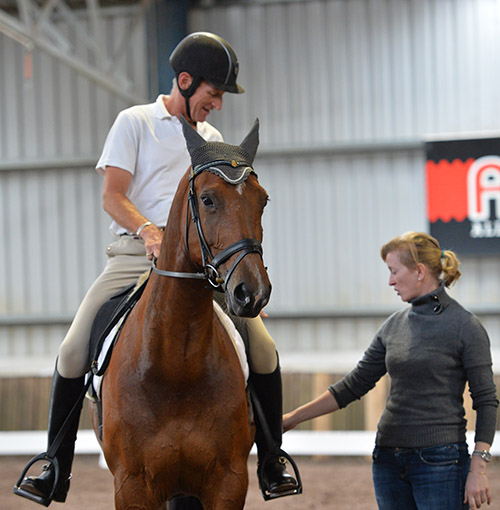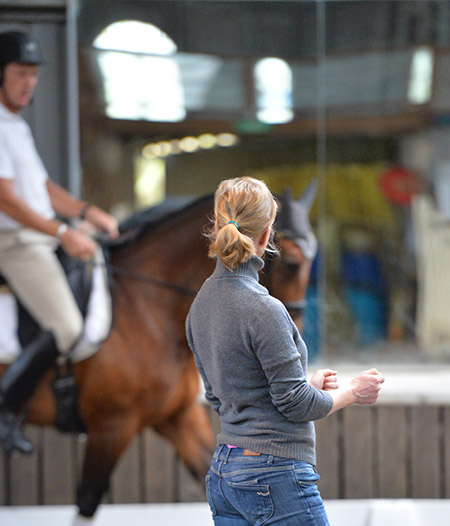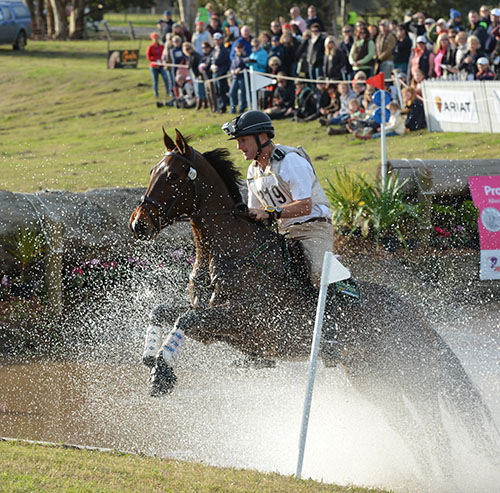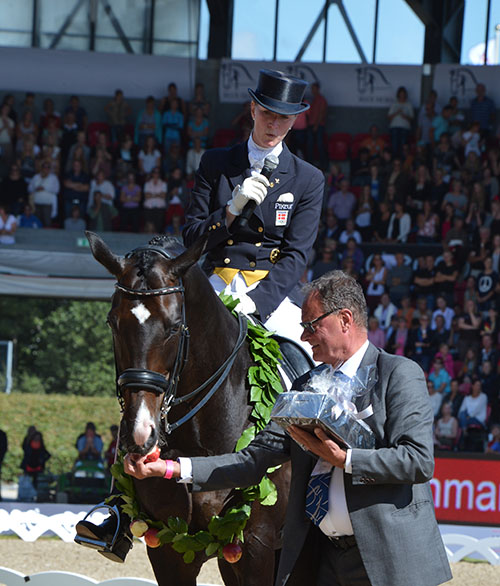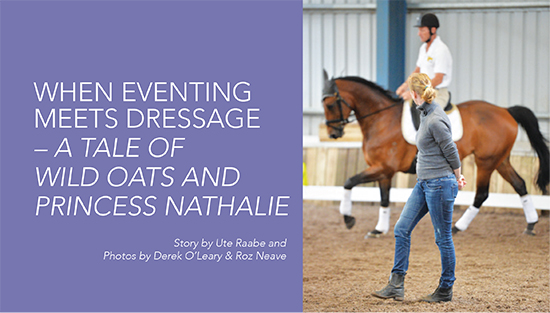
I have to admit, I am a little nervous meeting Princess Nathalie of Sayn-Wittgenstein-Berleburg, but I shouldn’t have worried. “Hi, I’m Nathalie!” the tall blonde dressed casually in down jacket, jeans and boots steps forward and a welcoming hand is extended coupled with a warm smile. It is a delight to work with the Princess, and as expected, she is as professional a dressage rider and coach as she is with interviews.
Nathalie is back at Jesmond Dene Equestrian Centre for her popular dressage clinics at which THM has been a regular guest. In the past we have featured on lessons with Gitte Donvig, Jason James, Maree Tomkinson and most recently Lilah Nieuwland. This time, to mix things up a little, we have invited four-star eventer Seumas Marwood with his 12-year-old mare Wild Oats by Contango II.
The lesson is split over two consecutive days. Seumas has only just returned from a national squad clinic in Sydney the day before where he received dressage training with Gareth Hughes. Again I am worried that lessons by two different coaches in the same week may confuse both horse and rider, but my concerns are unwarranted. Nathalie’s training philosophy goes hand in hand with Gareth Hughes’. And this is not because the two have a secret agreement; it is because it is the classical basic dressage training of inside leg to outside rein. “Isn’t it coincidental, you successful dressage riders have the same thoughts,” Seumas remarks light-heartedly.
But first things first… Seumas is warming up with a little leg yield. He has warned us that on the first day in a new environment Wild Oats is always very tense and that she will be much better on the second day. He is happy to work on Wild Oats’ frame and the basics of her paces on the first day. He would like to see her more compressed, but points out that this is quite hard for eventing horses who have a different schedule and muscle memory, “On the next day, she is galloping, and she has to be more stretched out again.”
“She does very good changes, she does a nice half pass, but unless we got that basic pace as good as it can be, we can only score as well as that basic pace is.”
Seumas admits that often the mare is not in front of his leg. He is not carrying a whip in today’s lesson and explains that, because in eventing dressage they are not allowed to have one, he never uses a whip in training.
Nathalie is advising him to warm her up like he normally does.
“You want her neck in front of you, keep the contact on the outside so that you can give and take on the inside rein. Try and do those little half-halts on the outside rein, good, but keep the bending flexion to the inside. You want to have the feeling, that when you come with the inside leg, she picks her stomach up between your legs. You can also once in a while flex her a little to the outside. Pretend you are going right hand but you are actually staying on the left hand.”
It is not so much bending, but just a light flexion to the outside.
Seumas is riding on a large circle around Nathalie, keeping a forward rising trot. The mare is indeed looking a little tense and missing that last bit of suppleness and elasticity in the neck and poll. She is not strong on Seumas’ hand, but rather hides away.
Nathalie instructs, “Show her the way with your inside hand. When you come with your leg, you have to get a reaction, make sure she steps away and forward from your inside leg. Keep pushing her into your outside rein, even when you make that half halt on the outside.”
She recommends doing a lot of trot-canter-trot transitions to ride the horse to the outside rein and comments on Seumas’ positioning of the hands, his head and body: “Not that you pull on the inside rein. Give and take, don’t just hold it there. Play with your inside rein, move your fingers as if you have a sponge in your hand and you are squeezing out the water. Your elbows stay by the sides of your body, otherwise you don’t have enough feeling. Don’t look down, when you drop your head and shoulders your weight is not on your seat bones. Shoulder blades back and straighten up, that gets the weight down into the saddle.”
The pair begins to canter and the same approach applies. “In canter flex her a little to the outside, play with the bit in her mouth. She has to loosen up in the poll. Have a little flex to the outside so you can move the inside rein.”
Wild Oats is still not quite round enough and not in front of Seumas’ leg. Nathalie tells us that just thinking of getting your horse rounder will help to make it happen, because you automatically give the aid. Think bigger canter stride, you want your horse to anticipate a rounder canter stride. “You will get a bigger jump in the canter, when you get her rounder. As soon as you think a bit quicker in the canter, it already happens.”
She also wants the mare to drop her head and stretch down. “In training don’t worry so much about getting her in front of the vertical, you want to get her rounder.” Seumas is working a little too hard on getting his mare moving forward and Nathalie is quick to point out, “Sit still, you can’t push her with your seat, she has to come from your leg. Be careful that you don’t push and push and nothing happens.”
Things begin to fall into place, suddenly Wild Oats’ hindlegs are more engaged and she is starting to let her neck drop. But Nathalie does not let them off, “Make sure she is really stepping into the outside rein when you bend her, don’t just bend her neck to the inside. When you go back into trot, you have a little outside flexion, just so that you can see her eye a little bit on the inside. Your left hand controls her left shoulder, your right hand controls her right shoulder.”
The next transition to trot is much better; the mare stays round and is accepting the contact and Seumas’ outside rein. Time for a little break. Nathalie is telling Seumas to ensure that he has a connection before moving up into trot again.
“When you kick you want a reaction in the forehand. You push the forehand away from you. Then she will come up in front without pushing her neck up. You want to feel her wither coming up. Keep your leg up at the girth, that’s where you get the forehand to move up.”
Nathalie calls Seumas over and moves his leg in the right position, closer to the girth. Seumas has a tendency to keep the lower leg too far back. He says it comes from riding many younger horses. Nathalie wants him to give the mare a kick just behind the girth, “I know she’s short, but kick her here, then you can push the forehand out of the rein. The moment you take your lower leg further back, you move away from the saddle. Then you feel you have to lean backward to get her in front of your leg. You want to tuck your seat bone, your bum underneath you.”
The next day, Wild Oats is moving much better from the start, she’s willing to listen and looks more supple and round. Seumas likes the concept of pushing the forehand out, and it sticks in his riding. Although he admits that it feels a bit ‘weird’. Nathalie responds, “She has to learn when you come with your leg, she has to move the forehand out of the way. You want to get to a point so that in the end you can give less and less intensive aids.”
One of the best things about having a lesson with the Danish team rider is, that she often gets very visual to demonstrate what she means. She moves up and down the arena and uses hands, legs and facial expression to get the message across. “You want to get her a bit more sensitive to your aids, you don’t want to nag, nag, nag and come with your leg this six, seven times. If she doesn’t react straight away at the first time, make her react the second time. Zak zak, zak – don’t wait until the fifth time!”
The mare responds to the aid but at the same time loses the contact. “Make sure she stays round, when you let go of the rein. The whole time you are in control of how much you can give on the inside rein.”
When the connection is re-established Seumas is moving on to a few of the movements required in eventing dressage, shoulder in, half pass and flying changes.
Nathalie comments on the half pass, “Keep your shoulder blades back, more bending, get the bending more through the corner, inside leg on.” Seumas and Wild Oats show an extended canter down the long side and Nathalie is happy, “Good, good, good!!”
In the extended trot however, the mare comes up too high in the neck. “In the extension she has to stay rounder. She has to learn to not just take the head up and run.” Nathalie’s recommendation is to start with shorter distances, instead of using the entire diagonal. Seumas is to ride only a few metres of extended trot or trying an extension on a circle. Extend and come back, extend and come back. Moreover, she wants him to stay in sitting trot. “When you are sitting, it is easier to use your stomach as well.”
Nathalie is impressed by Wild Oats’ flying changes, asking Seumas what marks he usually receives in a test and has no hesitation to say that she would give the mare a score of 7 or 8, “The one to the right is really good, for me it’s an 8!”
She advises in future training to emphasize the throughness, as the movements are not a problem for the mare. “The more supple she gets, the easier the movements will get. That’s what we dressage riders do. We go back, do our homework, get them supple in the canter and the trot.”
Seumas comments how mere mortals like him have to have these basics drilled into them. Nathalie somewhat disagrees, “I think when you once feel how it feels when it’s right, “ Nathalie snaps her fingers, “that is something you have on your memory. Then you know what you are after. Say if you would get on one of Ingrid’s (Klimke) horses, then you would feel immediately how it’s supposed to be.”
“The Germans have a tradition for dressage, the Australians have a tradition for cross country,” Nathalie adds. Let’s see if a lesson with the Danish Grand Prix star cannot change that…
About the rider
Seumas Marwood has his eyes firmly set on selection for WEG and Wild Oats (Contango II/Stirling Liberty) is his best chance. She recently produced twin foals by Kannan through embryo transfer. She has also produced consistent results on every Australian 3DE and ODE course, and is also a well-performed B-grade showjumper. The pair had a great 2013 season with highlights being third at the Melbourne CCI3* and sixth at the Adelaide CCI4*, less than 6 points behind the winner. This has earned them a place on the 2016 Rio Squad and a plane ticket to Europe. Seumas will set himself up with fellow Australian Christopher Burton at his yard in the UK and prepare for a shot at the Badminton Horse Trials.
“Between now and then we have a lot of work to do. If we win Badminton we stay…” Seumas adds with a wink
What did you think of the lesson?
“It was great, she (Nathalie) knows her stuff.”
“I am hoping it was a “ride changing” week for me, three days with Gareth Hughes in Sydney followed up with two great lessons with Nathalie. She was very demanding on my position, which was great for me. When you ride alone most of the time it is too easy to develop bad habits.”
“I think the most important correction was to have my lower leg a touch forward on the girth to help push the front legs away. The head up, shoulders back, elbows in is important to finish the picture but that lower leg really makes a big difference with this horse.”
“Nathalie was also very insistent on a quick response to the forward aid and total acceptance of the outside contact. I think in the past I have compromised that contact on order to allow her to go forward and round, she has to go forward off the first light aid, stay round and stay on the outside contact. Sometimes a little outside flexion was suggested and this also helped.
Wild Oats has definitely improved over the week, the forward but compressed frame that she used to fight against is becoming easier for her to maintain as the muscle memory develops. I am confident we are on track for a PB at Badminton, maybe then we will bump into the Princess again at WEG?”
15 minutes with Princess Nathalie
The last time I saw you was when we celebrated Digby’s farewell at the Euros in Herning…
“It wasn’t a complete farewell, he’s on a half pension. I decided not to have him for the team anymore; he’s done enough for the team. I don’t want him to battle for a place in the team because younger horses are coming up. He’s done a fantastic job for the horse he is. I thought it was just fair towards him to say, hey, you’ve done a really good job. He’s still motivated to do something, so that’s why we are doing some shows this year, which are fun, without pressure. We have an invitation to Doha in three weeks time, he loves the warm weather.”
That’s pretty soon…
“I have really good girls at home that keep my horses fit while I’m away. And he knows his job. He doesn’t have to do a lot of movements, he just has to be supple and motivated.”
Do you adjust his training now that he is older?
“When he is not in full work he doesn’t get any oats. In the last three years I cut his training down to really just round, basic work. He’s moving every day, but no big movements. I will do a little bit of shoulder in and half passes, that’s not a big strain on the joints. I won’t do any pirouettes, piaffe, passage – that’s there. Just two weeks before the show, I really build him up to it again and do a little more. It’s really only to keep him motivated, so he thinks it’s fun to go in and show off.”
Who might be taking his place?
“Well I have a home-bred mare that is on Grand Prix level now and has done Grand Prix shows which have been over my expectations. I also have a seven-year-old by Michellino at home that I think is a good horse. You never know what the judges think, but I like to work with him. He’s a quick and fast learner and has a lot of energy. He has the same sire as Mistral Hojris, he looks a bit like him too, chestnut with a white face, three white legs. Argentan blood on the damline. Nothing to shout ‘Hurrah’ but you don’t ride on the pedigree.”
You have a foal by Negro as well, the sire of Valegro…
“Yes, he is a yearling now. I have three foals from last year. Fürstenball, Negro and a Romanov. They are all ugly as hell at the moment. But conformation wise the Negro looks really nice. I only breed every second year, otherwise there are too many horses. In Denmark we are called the ‘stable-keep’, we are not so good at selling. My father always says ‘what if it develops really well and you have sold it, then you haven’t got the success with it’. I’m okay with that…”
Could the mare be a contender for WEG?
“I don’t know, it’s too early. She’s not a flashy mover but she does the exercises really nicely and she’s pretty, which is always a bonus. If I don’t get to go to WEG, you know what, it’s not a broken leg. I could have a summer holiday which I haven’t done for the last 15 years!”
“It’s nice to have a year without pressure. I love to have goals, but this year it doesn’t matter.”
The key message you give to the riders, inside leg, outside rein – it’s not rocket science.
“We have the same problems in Europe. Ground education, that the horse accepts the outside rein. In Europe you see a lot of horses that can do the movements at an early age, but they are not through. And then you get problems, the changes are not nice and yes, you have piaffe, passage, but you cannot put it all together because the ground education is not there. They don’t know a proper half halt and they don’t know how to stay up and supple. It’s the 1-0-1, children cannot go to university if they haven’t done primary school.”



